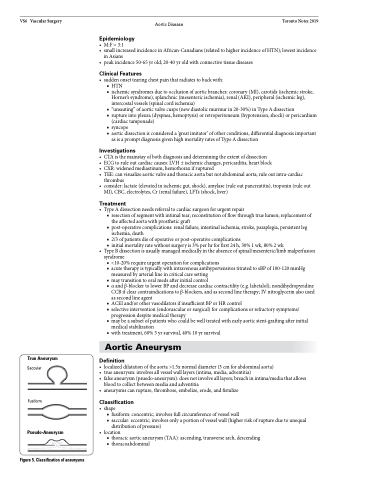Page 1370 - TNFlipTest
P. 1370
VS6 Vascular Surgery
Aortic Disease Toronto Notes 2019
True Aneurysm
Saccular
Fusiform
Pseudo-Aneurysm
Epidemiology
• M:F=3:1
• smallincreasedincidenceinAfrican-Canadians(relatedtohigherincidenceofHTN);lowestincidence
in Asians
• peakincidence50-65yrold;20-40yroldwithconnectivetissuediseases
Clinical Features
• suddenonsettearingchestpainthatradiatestobackwith: ■ HTN
■ ischemic syndromes due to occlusion of aortic branches: coronary (MI), carotids (ischemic stroke, Horner’s syndrome), splanchnic (mesenteric ischemia), renal (AKI), peripheral (ischemic leg), intercostal vessels (spinal cord ischemia)
■ “unseating” of aortic valve cusps (new diastolic murmur in 20-30%) in Type A dissection
■ rupture into pleura (dyspnea, hemoptysis) or retroperitoneum (hypotension, shock) or pericardium
(cardiac tamponade)
■ syncope
■ aortic dissection is considered a ‘great imitator’ of other conditions, differential diagnosis important
as is a prompt diagnosis given high mortality rates of Type A dissection
Investigations
• CTAisthemainstayofbothdiagnosisanddeterminingtheextentofdissection
• ECGtoruleoutcardiaccauses:LVH±ischemicchanges,pericarditis,heartblock
• CXR:widenedmediastinum,hemothoraxifruptured
• TEE:canvisualizeaorticvalveandthoracicaortabutnotabdominalaorta;ruleoutintra-cardiac
thrombus
• consider:lactate(elevatedinischemicgut,shock),amylase(ruleoutpancreatitis),troponin(ruleout
MI), CBC, electrolytes, Cr (renal failure), LFTs (shock, liver)
Treatment
• TypeAdissectionneedsreferraltocardiacsurgeonforurgentrepair
■ resection of segment with intimal tear; reconstitution of flow through true lumen; replacement of
the affected aorta with prosthetic graft
■ post-operative complications: renal failure, intestinal ischemia, stroke, paraplegia, persistent leg
ischemia, death
■ 2/3 of patients die of operative or post-operative complications
■ initial mortality rate without surgery is 3% per hr for first 24 h, 30% 1 wk, 80% 2 wk
• TypeBdissectionisusuallymanagedmedicallyintheabsenceofspinal/mesenteric/limbmalperfusion syndrome
■ <10-20% require urgent operation for complications
■ acute therapy is typically with intravenous antihypertensives titrated to sBP of 100-120 mmHg
measured by arterial line in critical care setting
■ may transition to oral meds after initial control
■ α and β-blocker to lower BP and decrease cardiac contractility (e.g. labetalol); nondihydropyridine
CCB if clear contraindications to β-blockers, and as second line therapy; IV nitroglycerin also used
as second line agent
■ ACEI and/or other vasodilators if insufficient BP or HR control
■ selective intervention (endovascular or surgical) for complications or refractory symptoms/
progression despite medical therapy
■ may be a subset of patients who could be well treated with early aortic stent-grafting after initial
medical stabilization
■ with treatment, 60% 5 yr survival, 40% 10 yr survival
Aortic Aneurysm
Definition
• localizeddilatationoftheaorta>1.5xnormaldiameter(3cmforabdominalaorta)
• trueaneurysm:involvesallvesselwalllayers(intima,media,adventitia)
• falseaneurysm(psuedo-aneurysm):doesnotinvolvealllayers;breachinintima/mediathatallows
blood to collect between media and adventitia
• aneurysmscanrupture,thrombose,embolize,erode,andfistulize
Classification
• shape
■ fusiform: concentric; involves full circumference of vessel wall
■ saccular: eccentric; involves only a portion of vessel wall (higher risk of rupture due to unequal
distribution of pressure) • location
■ thoracic aortic aneurysm (TAA): ascending, transverse arch, descending ■ thoracoabdominal
Figure 5. Classification of aneurysms


